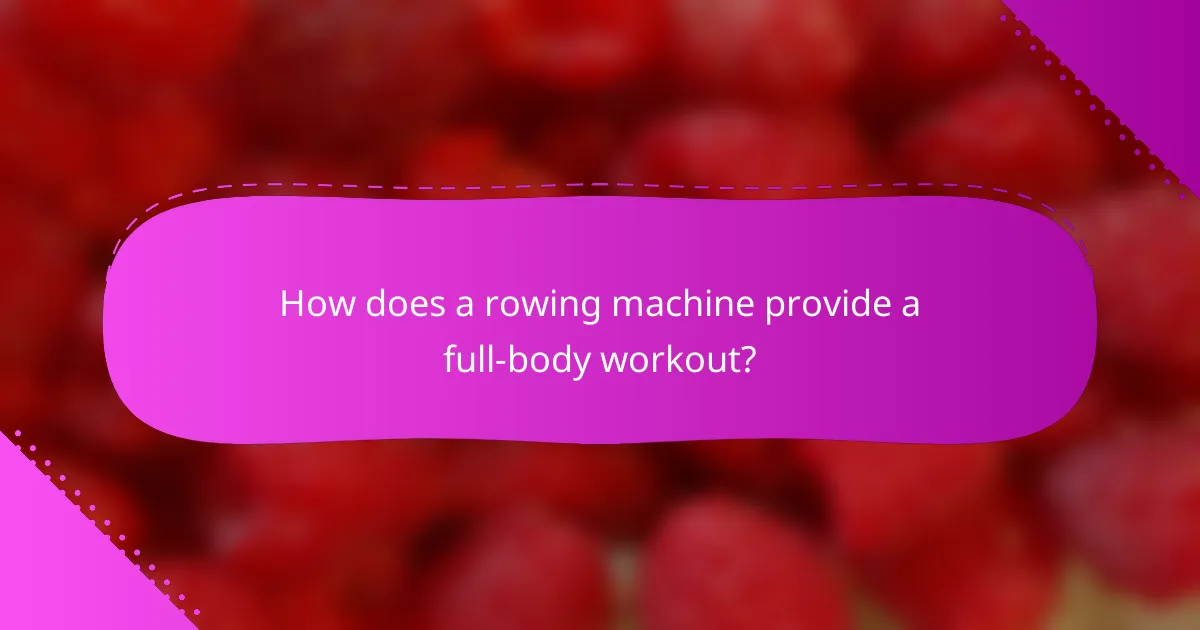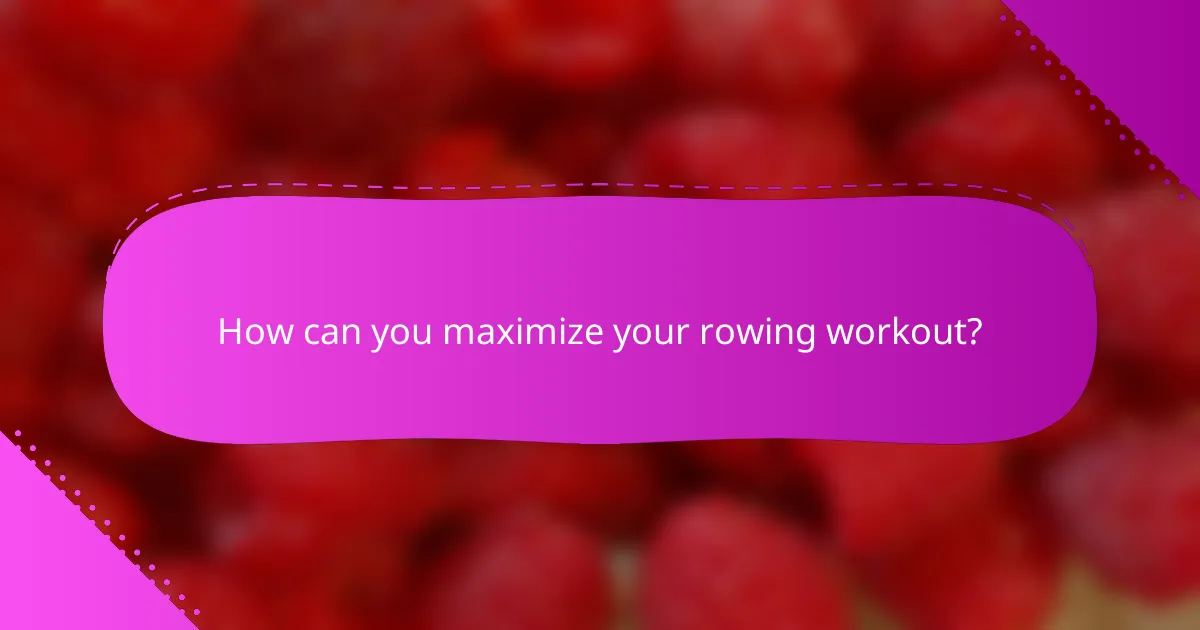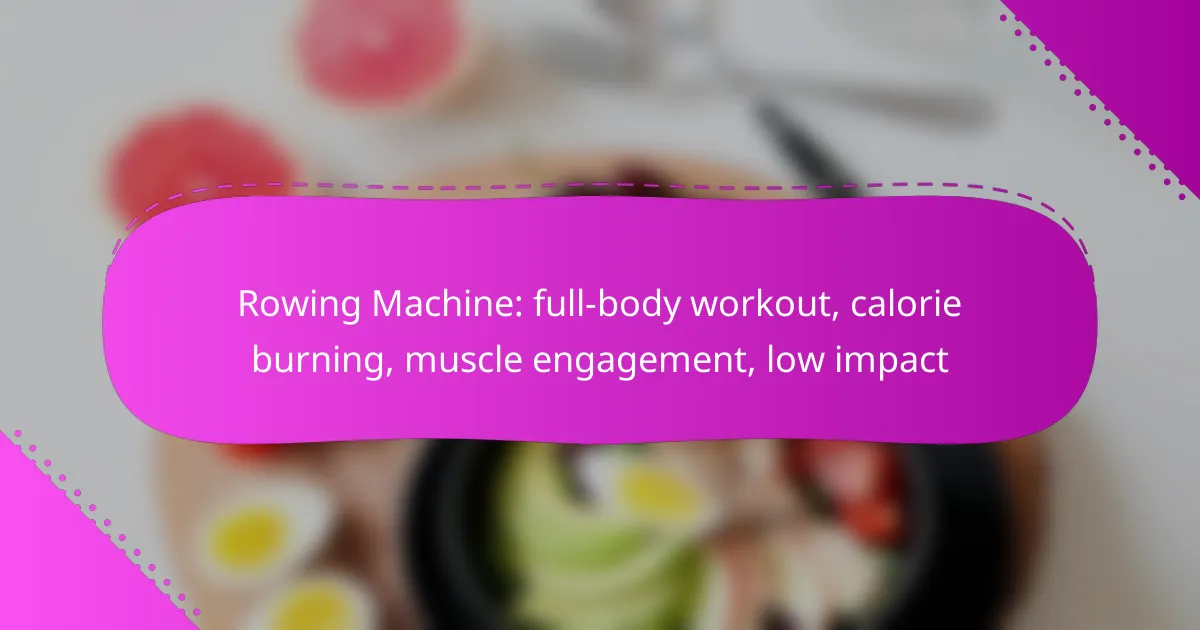The rowing machine provides an exceptional full-body workout that engages both upper and lower body muscles, promoting strength and endurance. As a low-impact exercise, it minimizes stress on the joints while effectively burning calories, making it ideal for individuals at various fitness levels. This versatile equipment combines aerobic conditioning with muscle engagement, supporting overall cardiovascular health and weight loss goals.

How does a rowing machine provide a full-body workout?
A rowing machine delivers a full-body workout by engaging multiple muscle groups while promoting cardiovascular health. This low-impact exercise effectively combines strength training and aerobic conditioning, making it suitable for various fitness levels.
Engages major muscle groups
Rowing machines target several key muscle groups, including the legs, back, arms, and core. The push-off from the legs engages the quadriceps and hamstrings, while the pull activates the back muscles, biceps, and shoulders. This comprehensive engagement helps build strength and endurance across the body.
During a rowing session, the continuous movement ensures that both the upper and lower body work in harmony, promoting balanced muscle development. For optimal results, aim for consistent workouts that last between 20 to 40 minutes, several times a week.
Improves cardiovascular fitness
Using a rowing machine significantly boosts cardiovascular fitness by elevating heart rate and promoting efficient oxygen use. As a low-impact exercise, it minimizes stress on the joints while still providing an effective aerobic workout.
To enhance cardiovascular benefits, maintain a steady pace that challenges your heart rate within a target zone, typically around 60-80% of your maximum heart rate. Regular sessions can lead to improved stamina and overall heart health.
Enhances core stability
Rowing requires core engagement throughout the entire movement, which helps enhance stability and balance. The core muscles, including the abdominals and obliques, work to stabilize the body during each stroke, contributing to better posture and functional strength.
To maximize core benefits, focus on maintaining proper form, keeping your back straight and engaging your core throughout the rowing motion. Incorporating core-focused exercises alongside rowing can further improve stability and strength.

What are the calorie-burning benefits of rowing machines?
Rowing machines offer an effective way to burn calories while engaging multiple muscle groups. This full-body workout can lead to significant calorie expenditure, making it a popular choice for those looking to lose weight or improve fitness levels.
Burns significant calories per session
During a typical rowing session, individuals can burn anywhere from 400 to 800 calories per hour, depending on intensity and body weight. This makes rowing machines one of the more efficient cardio options available. For example, a 155-pound person may burn around 600 calories in an hour of vigorous rowing.
Incorporating interval training on the rowing machine can further increase calorie burn. Alternating between high-intensity bursts and moderate rowing can elevate heart rate and enhance overall energy expenditure.
Factors affecting calorie burn
Several factors influence how many calories you burn while using a rowing machine. These include your weight, rowing intensity, duration of the workout, and individual metabolism. Heavier individuals generally burn more calories, while those who row at higher intensities will also see increased calorie expenditure.
Additionally, proper rowing technique can impact efficiency and calorie burn. Focus on maintaining a strong posture and using your legs, core, and arms effectively to maximize your workout. Avoid common pitfalls like slouching or using only your arms, as these can reduce the effectiveness of your session.

How do rowing machines engage muscles effectively?
Rowing machines engage muscles effectively by utilizing a full-body motion that incorporates both upper and lower body muscle groups. This low-impact exercise promotes strength and endurance while minimizing stress on joints.
Muscle engagement during strokes
During each stroke on a rowing machine, major muscle groups are activated, including the legs, back, and arms. The initial drive comes from the legs, followed by the engagement of the core and upper body as you pull the handle towards you. This coordinated movement ensures that multiple muscle groups work together, enhancing overall strength and endurance.
Rowing primarily targets the quadriceps, hamstrings, glutes, back, and shoulders, making it an efficient workout for muscle engagement. As you row, the resistance can be adjusted, allowing for a customizable intensity that can further challenge your muscles.
Comparison with other cardio equipment
When compared to other cardio machines like treadmills or stationary bikes, rowing machines offer a unique advantage by providing a comprehensive workout that engages more muscle groups simultaneously. While treadmills primarily focus on lower body muscles, and bikes emphasize leg strength, rowing machines distribute the workload evenly across the body.
Additionally, rowing machines are low-impact, which makes them suitable for a wider range of fitness levels and minimizes the risk of injury. This makes them an excellent choice for individuals looking to improve cardiovascular fitness while also building muscle strength.

What makes rowing machines low impact?
Rowing machines are considered low impact because they minimize stress on the joints while providing a full-body workout. The smooth, gliding motion of rowing reduces the risk of injury, making it suitable for individuals of various fitness levels.
Reduced stress on joints
Rowing machines allow for a fluid motion that engages multiple muscle groups without jarring impacts. Unlike running or high-impact exercises, the rowing stroke involves a controlled pull and push, which helps protect the knees, hips, and back from excessive strain.
This low-impact nature is particularly beneficial for those with joint issues or those recovering from injuries. Regular use can help strengthen the muscles around the joints, providing better support and stability over time.
Suitable for rehabilitation
Rowing machines are often recommended in rehabilitation programs due to their low impact and ability to strengthen muscles gradually. They allow users to engage in cardiovascular exercise while minimizing the risk of aggravating existing injuries.
Physical therapists may incorporate rowing into recovery plans for conditions such as knee injuries or lower back pain. It’s essential to start at a comfortable intensity and gradually increase resistance and duration as strength improves.

What are the best rowing machines available in Australia?
The best rowing machines in Australia combine durability, performance, and user-friendly features. Popular options include the Concept2 Model D, WaterRower Natural, and NordicTrack RW900, each offering unique benefits for full-body workouts and calorie burning.
Concept2 Model D
The Concept2 Model D is widely regarded as a top choice for both home and commercial use. It features a flywheel design that provides a smooth rowing experience, allowing users to engage multiple muscle groups effectively.
This machine is equipped with a performance monitor that tracks distance, speed, and calories burned, making it easy to set and achieve fitness goals. Its adjustable footrests and ergonomic handle enhance comfort during workouts.
WaterRower Natural
The WaterRower Natural utilizes water resistance to create a realistic rowing experience, mimicking the feel of rowing on water. This feature not only engages muscles but also offers a visually appealing design made from solid ash wood.
Users appreciate its low-impact nature, making it suitable for all fitness levels. The WaterRower’s unique resistance system allows for a smooth transition between different intensity levels, accommodating both beginners and advanced rowers.
NordicTrack RW900
The NordicTrack RW900 stands out with its interactive touchscreen display and iFit compatibility, providing access to a wide range of workouts and coaching. This machine combines air and magnetic resistance for a customizable rowing experience.
With built-in speakers and adjustable resistance levels, users can enjoy immersive workouts that keep them motivated. The RW900 is designed for comfort, featuring a padded seat and ergonomic handle, making it a great option for long sessions.

What should you consider when choosing a rowing machine?
When selecting a rowing machine, consider factors such as resistance type, size and storage options, and price range. These elements will significantly impact your workout experience and overall satisfaction with the equipment.
Resistance type
Rowing machines typically use one of three resistance types: air, magnetic, or water. Air resistance machines provide a dynamic feel, adjusting the intensity based on your rowing speed, while magnetic machines offer a quieter experience with consistent resistance. Water rowers simulate the feel of rowing on water, providing a unique experience but often at a higher price point.
Choose a resistance type that aligns with your fitness goals and preferences. For example, if you prefer a quiet workout, a magnetic rower may be ideal, while those seeking a more authentic rowing experience might opt for a water rower.
Size and storage options
Consider the dimensions of the rowing machine and your available space. Some models are compact and foldable, making them suitable for smaller areas, while others may require more room for use and storage. Measure your workout space to ensure a good fit.
Additionally, look for machines with built-in wheels for easy transport or those that can be stored vertically. This can be particularly useful if you have limited space.
Price range
The price of rowing machines can vary widely, typically ranging from a few hundred to several thousand dollars. Budget models may lack advanced features but can still provide a solid workout, while high-end machines often include additional technology and durability.
Determine your budget and consider what features are essential for your workouts. Investing in a quality machine can enhance your fitness routine, but ensure it meets your needs without overspending.

How can you maximize your rowing workout?
To maximize your rowing workout, focus on maintaining proper form, adjusting resistance levels, and incorporating interval training. These strategies enhance muscle engagement, boost calorie burning, and ensure a full-body workout.
Focus on form
Proper rowing form is crucial for maximizing effectiveness and minimizing injury risk. Keep your back straight, engage your core, and drive through your legs before pulling with your arms. This technique ensures that you engage major muscle groups, including your legs, back, and arms.
Regularly check your posture and hand positioning. Your hands should grip the handle lightly, and your elbows should remain close to your body during the pull phase. This alignment helps in distributing the workload evenly across your muscles.
Adjust resistance levels
Adjusting the resistance on your rowing machine can significantly impact your workout intensity. Higher resistance levels can enhance muscle engagement, while lower levels may be better for endurance training. Experiment with different settings to find what challenges you without compromising form.
A good rule of thumb is to start with a moderate resistance and gradually increase it as your strength improves. Aim for a resistance level that allows you to maintain a steady pace while still feeling challenged after several minutes of rowing.
Incorporate interval training
Interval training can significantly boost calorie burning during your rowing workouts. Alternate between high-intensity bursts and lower-intensity recovery periods. For example, row at a high intensity for 30 seconds, followed by one minute of slower rowing.
This approach not only increases your overall calorie expenditure but also improves cardiovascular fitness. Aim for a ratio of 1:2 for high-intensity to recovery periods, adjusting as needed based on your fitness level.
